
Both Digital Aquatics and Eshopps recently released float switch kits in the market with two different approaches—Eshopps is great for adding a simple analog top off float valve and Digital Aquatics for harnessing the power of your aquarium controller. Looking for a simple setup for an automatic top off setup? The Eshopps kit might be what you are looking for. Using a simple “ball†style float using no electricity or moving parts. As the water level rises, the ball activates the swing arm closing off the water flow. This kit retails for under $30 and comes with a nice sturdy and fully adjustable acrylic holder with a 6-inch range to dial it in to exactly where you want. This unit would be best served using a gravity-fed top off reservoir and  could be plumbed right into your RO or RO/DI unit. The Digital Aquatics switch kit is definitely a bit more complex but could be used in a huge array of setups working in conjunction with your ReefKeeper Elite or ReefKeeper Lite system.  Basically any place you have a liquid you can program it – ATO system, automatic water transfers, setup safety alerts for high and low water levels, alert for when your skimmer collection is about to spew nasty skimmate and more. The Digital Aquatic kits use small micro-floats and come in three kits that include programming instructions and an installation guides. They also include a sturdy acrylic mount to add it to your display, sump, or refugium. The DA kits cost $15.99 for just the switch and adapter kit,  $24.99 for the switch, adapter kit and mounting bracket and $44.99 if you want to double everything up (two switches, two adapter kits and two brackets). The DA kits definitely offer more diversity in applications but are geared towards RKE and RKL owners exclusively while the Eshopps kit would work for most hobbyists although the ball switch does require more room in your sump or reservoir. For the technophiles looking for something more cutting-edge there’s always the GHL ProFilux external level sensor we posted earlier.
could be plumbed right into your RO or RO/DI unit. The Digital Aquatics switch kit is definitely a bit more complex but could be used in a huge array of setups working in conjunction with your ReefKeeper Elite or ReefKeeper Lite system.  Basically any place you have a liquid you can program it – ATO system, automatic water transfers, setup safety alerts for high and low water levels, alert for when your skimmer collection is about to spew nasty skimmate and more. The Digital Aquatic kits use small micro-floats and come in three kits that include programming instructions and an installation guides. They also include a sturdy acrylic mount to add it to your display, sump, or refugium. The DA kits cost $15.99 for just the switch and adapter kit,  $24.99 for the switch, adapter kit and mounting bracket and $44.99 if you want to double everything up (two switches, two adapter kits and two brackets). The DA kits definitely offer more diversity in applications but are geared towards RKE and RKL owners exclusively while the Eshopps kit would work for most hobbyists although the ball switch does require more room in your sump or reservoir. For the technophiles looking for something more cutting-edge there’s always the GHL ProFilux external level sensor we posted earlier.



